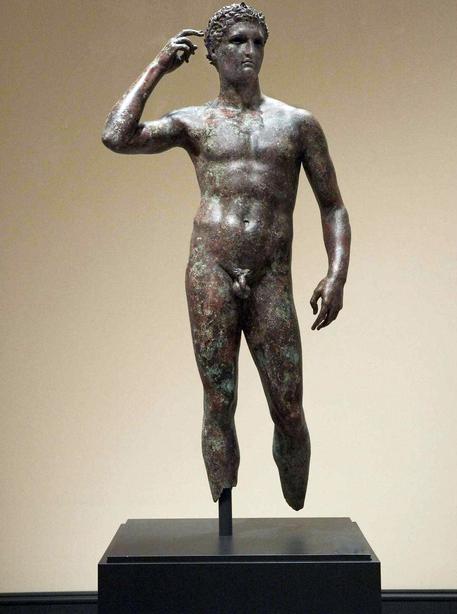Getty Museum fighting confiscation of bronze 'Victorious Youth'
(ANSA)
- Rome, May 7 - Italy's highest appeals court on Wednesday was asked
to order a major American museum to return an ancient bronze statue
known as Victorious Youth which has been at the centre of a
long-running dispute. The world-famous artifact, which was found in
the sea near the Adriatic coastal city of Pescara 50 years ago, must
be returned from the John Paul Getty Museum in California, said
Francesco Salzano, assistant attorney general of the third criminal
chamber of the Cassation Court.
He was challenging an appeal by Stephen Clark, lawyer for the Getty Trust, which opposes a 2012 court order for the confiscation of the 4th-century BC Statue of a Victorious Youth. It is believed to be the handiwork of Lysippos, perhaps the most acclaimed of ancient Greek sculptors, who grew to fame under the patronage of Alexander the Great.
The Getty museum acquired the statue in 1977 and created a special space to conserve the bronze, which is viewed by about 400,000 visitors each year, said the American museum. Italy's culture ministry officials have been closely tracking the case, particularly in light of a 2008 accord whereby the Getty returned contested works in exchange for increased collaboration on digs and restoration of antiquities. Also known as the "Getty Bronze", the statue was not included in that agreement on contested antiquities between Italy and the Getty that saw the return of art treasures including a famous 5th-century BC statue of Aphrodite. Italy and the Getty also agreed under that deal to bolster their cultural relations through important loans, joint exhibitions, research and conservation projects. One of the latest episodes in the decades-old legal wrangle over the statue was sparked in 2010 when Pesaro Judge Lorena Mussoni ruled that the statue be "confiscated from the museum" and returned to Italy immediately.
Mussoni's decision overturned a ruling by the same court which two years ago rejected Italy's petition to have the statue seized because of a lack of evidence of smuggling. But Mussoni argued that it became state property the moment it was fished out of the Adriatic in 1964 and could not have been sold afterwards without breaking Italian laws on antiquities. The Getty Museum has consistently fought past Italian attempts to recover the statue.
Italian culture officials claim the art dealers who sold it to the Getty smuggled the statue out of the country, and have demanded the museum hand it back. But their petition was rejected in November 2008 by another Pesaro judge on the grounds the statue's purchase came after a Rome court ruling that dismissed charges of smuggling for lack of evidence. Other trafficking charges have either lapsed under the statute of limitations or are no longer applicable because of the death of the fishermen who found it and the art dealers involved in its sale, the judge said. It was impossible to prove that the museum knew the object had been smuggled out of Italy, the judge added.
The statue has been contested ever since the Getty bought it for some four million dollars in 1977 - almost 800 times the $5,600 paid to the fishermen who sold it to Italian dealers in 1964. It remains unclear how the piece came into the museum's collection, where it re-emerged after disappearing for some 13 years and, according to one expert, changing hands across the Atlantic at least twice.

Nessun commento:
Posta un commento